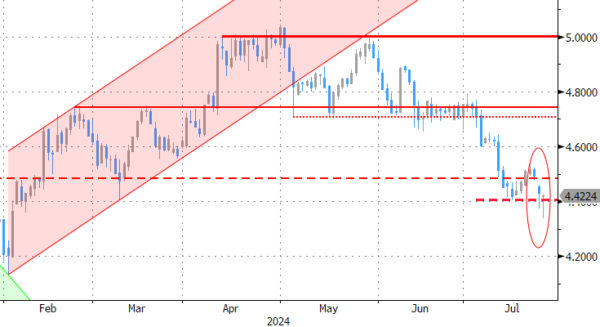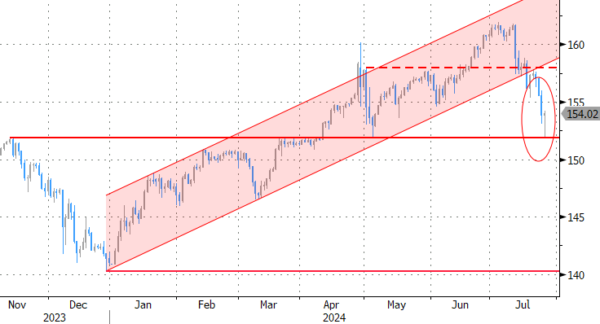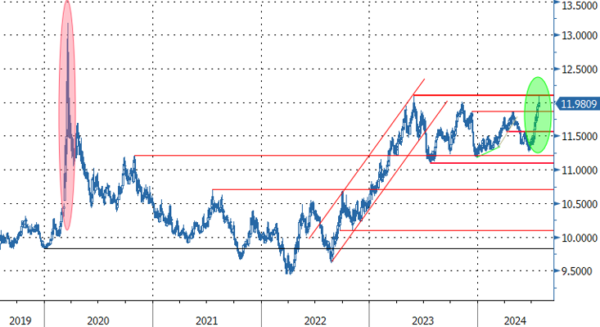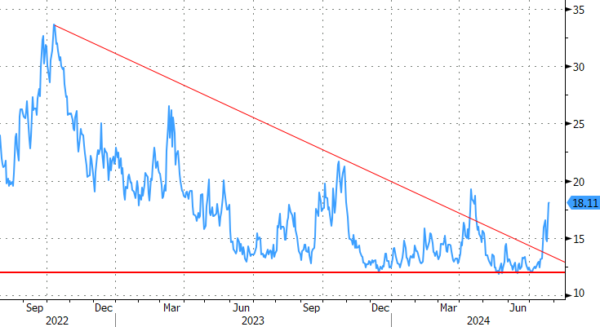Markets
Risk off quickly spread from the US yesterday to Asian and later European dealings today. Triggered by AI/tech companies on Wall Street yesterday, the equity sell-off broadened in the likes of the EuroStoxx50 amid weaker guidance from consumer staples (including Nestlé). Losses at some point amounted to 1.7% and are as much as 2.5% in Italy. The slide in US stock markets eased a bit, with indices opening between -0.3% and +0.1%. US yields built on their recent correction by shedding between 7-9 bps going into the release of a series of important economic data. After a (long) string of disappointments, markets long for some upbeat news. Yesterday’s PMI’s were not at all bad (especially services) but didn’t quite get the job done. US Q2 GDP growth today came in at 2.8% q/q annualized, double the pace in Q1 and easily topping the 2% estimate. Personal consumption (2.3%) contributed more than half (1.57 ppts) with gross private investment (8.4%) securing the second place (1.46 ppts – 0.82 ppts of which driven by rising inventories). Government consumption (3.1%) added 0.53 ppts while net exports served as a drag (-0.72 ppts) amid rising imports (6.9%) outpacing exports (2.0%). The PCE price deflator missed the bar on a headline level (2.3% in Q2 vs 2.6% expected, down from 3.1%) but was higher-than-anticipated in the underlying gauge (from 3.7% to 2.9% vs 2.7%). Weekly jobless claims came in slightly less than feared (235k) and (core) durable goods orders – barring the major headline miss on non-defense aircraft orders – mostly came in to the stronger side of expectations. Yields welcomed the news by paring losses a bit to 2.5-5 bps across the US curve. The 2-yr yield tested 4.33% support before revisiting 4.40% again. Money markets barely changed their Fed rate cut expectations for the year though. Assuming no decision is made in November, investors are still pondering the chances for a sizeable 50 bps cut somewhere this year. The US data help European yields to find an intraday bottom as well with German yields almost fully erasing 5-7 bps of losses. In European swap yields, the 2-yr yield’s break below 3% is less compelling than it was before the numbers rolled in. UST underperformance and increased speculation/anticipation on the Fed easing cycle keeps the dollar at bay even at times of risk aversion such as today. EUR/USD loses some ground to 1.0835. USD/JPY made a sharp U-turn following the data batch, rebounding from as low as 151.94 to 153.92.
News & Views
Business sentiment and activity among British manufacturers as captured in the Quarterly Industrial Trends survey of the Confederation of British Industry (CBI) showed some mixed signals, but CBI assessed the outlook as fairly constructive. Optimism among manufacturers fell slightly in July, after rising in April for the first time in nearly three years (balance -9 from +9 in April). Output volumes were broadly unchanged in the quarter to July (-3 from +3), following a similar result in the three months to June and underperformed expectations for modest growth. However, manufacturers continue to expect output to increase over the next three months (+25%), with growth expectations the strongest since March 2022. Average cost growth accelerated compared with April and remained elevated compared to historical norms (+52% from 39%, historical average +18%). Cost growth is expected to slow in the quarter to October, while remaining historically strong. Domestic and export price inflation also accelerated but are both expected to slow in the next three months. Meanwhile, manufacturers expect to raise their headcount in the next three months (and at the fastest pace for a year), and investment intentions for the year ahead have generally improved. As was the case with other UK data evidence, the CBI survey today provide no clear message whether the BOE should/can already cut rates at next week’s MPC meeting.
Confidence in the Norwegian industrial sector as measured by the business tendency survey for manufacturing, mining and quarrying improved to 3.9 in the second quarter from 0.6 thee in April. Business assessment improved for all measured variables (total production volume, average employment, new orders received from home markets and new orders received from export markets) both for the current assessment and for expected changes compared to the next quarter. Still better industrial prospects didn’t help the Norwegian currency. The negative global sentiment vs smaller, commodity related currencies today culminated in a test of the EUR/NOK 2023 high by EUR/NOK. NOK losses were paired afterwards to 11.98 currently.
Graphs
US 2-yr rebounds from 4.33% support to trade back north of 4.40% amid strong Q2 growth
USD/JPY stages sharp intraday U-turn as solid-to-strong eco data eases some downturn concerns
EUR/NOK: krone tested 2023 highs as risk aversion continues to dominate on markets
VIX index jumped from recent historical lows. Sell-off wave rolls over equity markets

















